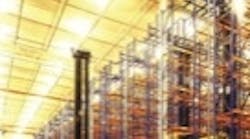New methods and ways of working have always been an area of interest for John Galiher, president and CEO of Preferred Freezer Services, a Jersey City, N.J.-based refrigerated warehouse company. It operates 17 facilities across the United States with five additional warehouses actively under construction. It had close to $100 million in sales in its most recent fiscal year, and more than 99 million cubic ft. of cold storage space.
When Galiher started Preferrred Freezer Services (www.preferredfreezer.com) in 1989 with one warehouse in New Jersey, it was common for warehouses to be designed with very narrow aisles (VNA) and racks to about 35 feet in height. Employees, dressed for the subzero environment, drove turret trucks and manipulated pallets above their heads. Galiher, an engineer, had constructed a number of VNA facilities that used man-up, hydraulic battery powered VNA units. He was convinced there were ways of improving storage and operating efficiency. He also wanted to reduce maintenance and battery changing time on the machines.
In 1998, Galiher took his ideas to FKI Logistex. "The original FKI Logistex machine we looked at in 1998 had features that didn't work for us," he says. "It wasn't tall enough to gain the benefits of extra storage height and it could only go down the aisle in one direction, which would have lost us pallet locations."
"With a counter-balanced hydraulic machine, the higher you lift the less weight you can lift, which reduces my storage flexibility," Galiher explains. "Also, once you get above a certain elevation, you start slowing down traction speed." He also found that battery changing and recharging outside of the cold store was a time consuming and inefficient task.
Galiher visited FKI Logistex-designed facilities in the United Kingdom and made several design suggestions that eventually became part of the FKI Logistex Condor VNA automated storage and retrieval system (AS/RS). Preferred Freezer Services recently contract FKI to provide more than 100 Condor cranes.
The Condor hybrid crane stores and retrieves pallet-size loads in high-bay, very narrow aisles. Top-guidance and a fully enclosed, heated cabin enable Preferred Freezer to support high levels of throughput, accuracy and productivity. The crane works in aisle widths of 70 in minimum and lifts to heights approaching 50 ft. Its maximum capacity of 3,300 lbs is available at any elevation. In-aisle conductor rails electrify the AC-powered hoist and charge the onboard traction battery, eliminating battery changing and the need for a charging area, which frees up floor space for other purposes. Twin power picks allow the cranes to be operated in either direction.
Other modifications driven by Preferred's input include an onboard camera and monitor, which gives the driver a clear view behind, making in-aisle reversing a safer operation. The "AC units are more efficient," Galiher says. "You don't use as much energy converting from AC to DC to battery and back to a motor. Hydraulic units are compact, but they are not necessarily energy efficient. An electric motor winding a gearbox and driving a winch uses less energy."
Another issue for Galiher was maintenance. An electric motor to a direct-drive gearbox does not require as much maintenance as hydraulic pumps, valves, hosing and fittings, he says. Such maintenance issues can be exaggerated in a freezer applications where hoses become brittle and crack and where hydraulic fluids need certain viscosities.
Hydraulic leaks are a real problem, Galiher says. "It is not like a forklift with two gallons of fluid. When you blow a hose 40 ft. in the air they spray all over the place—on the product, on the forklift and all over the floor. So we have eliminated the leaks and the mess they make. It's just simpler, cleaner and more reliable."
The extended height capability of the equipment allows Preferred Freezer to build taller facilities, which gives it an additional level or two of pallet space compared to facilities with similar square footage. "The machine we have can take the weights we need to a higher elevation. And that extra height is giving us a more competitive price per cube or per pallet," he explains. "The cost of construction per (cubic foot) comes down as the building goes higher."
Preferred Freezer also has a fixed-price, full-service, parts-and-maintenance contract with FKI for all of its sites using the Condor system. The agreement budgets annual preventive maintenance and provides complete coverage for everyday and predictive maintenance, normal-use parts and emergency breakdown repairs.
Higher lift heights give Preferred Freezer Services the ability to build taller warehouses that hold more pallets.



